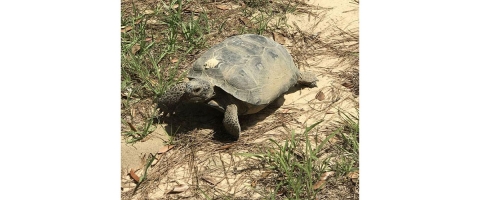Camilla, Georgia — Hurricane Michael barreled across prime Southern timber territory, damaging five million acres of pines and hardwoods and destroying nearly $1.7 billion worth of marketable trees. Habitat for many of the region’s at-risk species — red-cockaded woodpeckers, gopher tortoises, eastern indigo snakes — was sundered.
Now, six weeks after Michael killed more than 45 people in Florida, Georgia, North Carolina and Virginia, forest owners salvage timber, clear stands and pray for a market rebound. Wildlife biologists fan out across public and private land investigating the harm done to habitats and animals above and below ground.
“We’ve had damage across the entire farm; trees have snapped off completely,” said Joe Butler Jr., a fifth-generation farmer in southwest Georgia. “It’s devastating both financially and environmentally. We have lost several hundred thousand dollars of timber. At times it makes me want to cry.”
Butler gave a “longleaf pine restoration field tour” one recent rainy Tuesday to three dozen conservation-minded officials from the Southern Company, Georgia Forestry Commission, U.S. Fish and Wildlife Service, state agencies and local media. The tour was prompted by a record $6.5 million in grants awarded this year by the National Fish and Wildlife Foundation to boost longleaf pine forests across eight Southern states. These grants are funded with support from a mix of federal and non-federal partners, including the U.S. Department of Agriculture, Southern Company, International Paper and American Forest Foundation. The money is matched with $7.9 million from grant recipients. In all, the grants should establish 17,000 new acres of the long-living pine, as well as improve 335,000 acres of pine habitat critical for several at-risk species.
Planting longleaf, post-Michael, looks like a safe bet.
“Obviously, with 110-plus mile-per-hour winds you’re going to get indiscriminate damage everywhere,” said Jim Bates, a Fish and Wildlife biologist who has helped restore habitat on the Butler’s farm since the early 2000s. “But the longleaf holds on stronger because of the size of its tap root. We’ve been fortunate here.”
Michael roto-tilled his way across a swath of the Florida Panhandle and southwest Georgia on October 10-11. He largely missed, though, some of the region’s major longleaf pine forests at Eglin Air Force Base, Conecuh National Forest, Okefenokee National Wildlife Refuge and Fort Stewart Army Base. Yet smaller longleaf stands, and some pockets of original longleaf, were hammered by the storm.
In all, Michael damaged nearly three million acres of pine and hardwood in Florida valued at $1.3 billion, according to the state’s agriculture department. In Georgia, two million acres worth an estimated $374 million were lost.
“That’s how much timber we’ve got laying on the ground,” said Mark McClellan, a regional specialist with the Georgia Forestry Commission.
The Butlers first planted longleaf in 2000. Today, about one-fifth of their 1,500-acre farm is given over to the sturdy, fire-resistant pine. Forest Lodge Farms was put into a permanent conservation easement conservation easement
A conservation easement is a voluntary legal agreement between a landowner and a government agency or qualified conservation organization that restricts the type and amount of development that may take place on a property in the future. Conservation easements aim to protect habitat for birds, fish and other wildlife by limiting residential, industrial or commercial development. Contracts may prohibit alteration of the natural topography, conversion of native grassland to cropland, drainage of wetland and establishment of game farms. Easement land remains in private ownership.
Learn more about conservation easement in 2007 ensuring that only trees could be grown and sold. Lack of agricultural diversification can prove costly when a hurricane rolls through.
Butler detailed the damage as the tram rolled across his farm. A 175-acre stand of 18-year-old longleaf had just been thinned before Michael. The stand looked a mess with many trees mangled or bent at 45-degree angles. Maybe one of every five trees on his farm was damaged, Butler reckons, which the forestry commission would deem a “moderate” loss.
“But since we’re in an easement, all I can do is sell timber and all that timber is lost,” said Butler, 67.
His mood brightened as the tram rolled along. He’s a longleaf convert, after all, committed to the tree’s long-term economic and environmental benefits. He burns routinely, and rotationally, in 15-acre increments ensuring a lovely mosaic pattern of open-canopied tracts of land with wiregrass and saw palmetto carpeting the ground.
“This is a lovely longleaf stand here,” said Butler, the 2013 Tree Farmer of the Year in Georgia. “It’s sandy and full of pockets of gopher tortoises. You can sit out here and hear quail calling from five different directions.”
Orange flags mark the tortoise burrows; biologists across Georgia and Florida have been busy removing downed trees and debris from the holes. Tortoises are a so-called keystone species whose burrows attract upwards of 350 other critters including snakes, birds, frogs, mice and spiders.
“Every tree that blows down gives a little more daylight to the ground,” Butler said. “Grasses can grow, gopher tortoises will move in, and that’s how the longleaf pine system has always been. There’s always been disturbances — hurricanes, tornadoes, fires. … It’s all a part of the life cycle of the longleaf pine ecosystem.”
Tortoises, with their tank-like shells and centuries-old instinct for shelter, largely survived the hurricane unscathed. A fellow longleaf habitué — the red-cockaded woodpecker (RCW) — suffered more. The U.S. Fish and Wildlife Service and other federal, state and nonprofit agencies have worked assiduously to get the woodpecker off the endangered species list.
The Apalachicola National Forest, 90 miles south of Camilla, tallied 833 “active” woodpecker clusters before Michael. (A cluster is, on average, 10 acres.) Apalachicola is home to more woodpeckers than any other forest.
“The national forest got hammered,” said Bates, the Service biologist. “Of course how goes the habitat goes the species. If they didn’t get into a cavity, they could’ve been exposed to predators more so than usual.”
RCWs, like gopher tortoises, depend upon longleaf for survival. The longleaf forest once spread over 90 million acres between Virginia and Texas. Today, less than five million acres remain. The woodpecker was listed as endangered in 1970.
The U.S. Forest Service surveyed Apalachicola by air and ground to determine damage to trees, clusters and artificial homes, or cavities, for woodpeckers. Roads were then cleared and teams of two surveyed the area and began replacing damaged cavities. Will McDearman, the Service’s RCW recovery coordinator, said 600 artificial cavities may be needed.
It could have been worse. The hurricane’s major winds stayed on Apalachicola’s western fringe, avoiding major woodpecker clusters further east. The new cavities are already attracting displaced woodpeckers. And Michael wasn’t Hugo.
Hurricane Hugo, a Category 4 monster, hit Francis Marion National Forest in South Carolina head on in 1989. The forest, at the time, had the largest population of woodpecker clusters — 480. Roughly 160 of the clusters were wiped out.
“Hurricane Hugo was our benchmark,” McDearman said. “We were in the early days of RCW management with artificial activities. That’s where the success of artificial cavities were demonstrated for the first time. We were desperate. We had to try something.”
Today, 488 active woodpeckers clusters dot Francis Marion. But it took nearly 30 years to restore the RCW population, evidence that the South’s recovery from Hurricane Michael won’t happen overnight. Forests must be cleared of downed trees. Cavities restored. Longleaf replanted.
“You can’t grow a 60-year-old tree in one day. It takes time to grow a forest and return it to the desired condition,” McDearman said. “Besides, hurricanes are naturally occurring events. We know that we can restore forests, and woodpecker populations, after devastation.”








